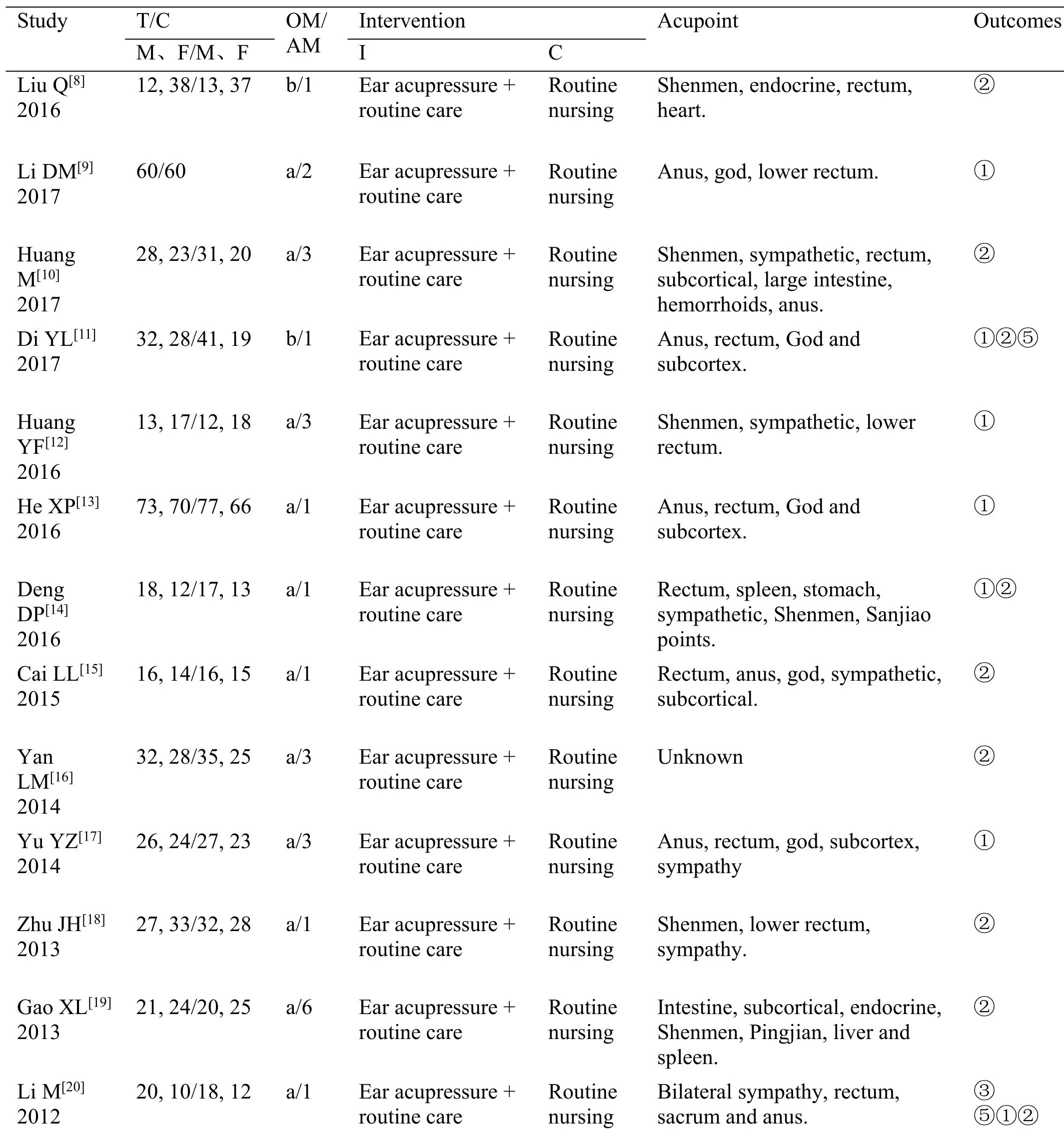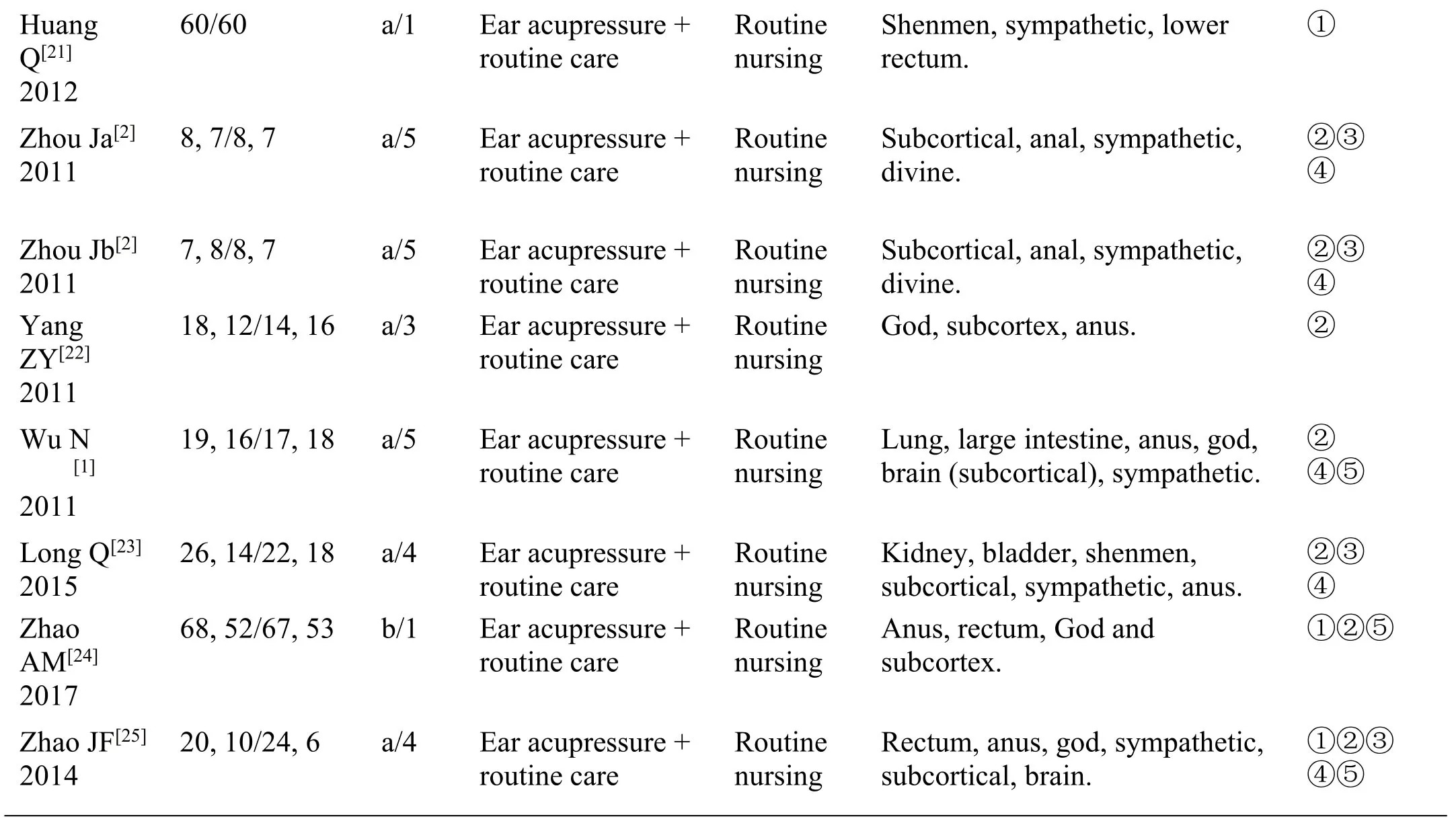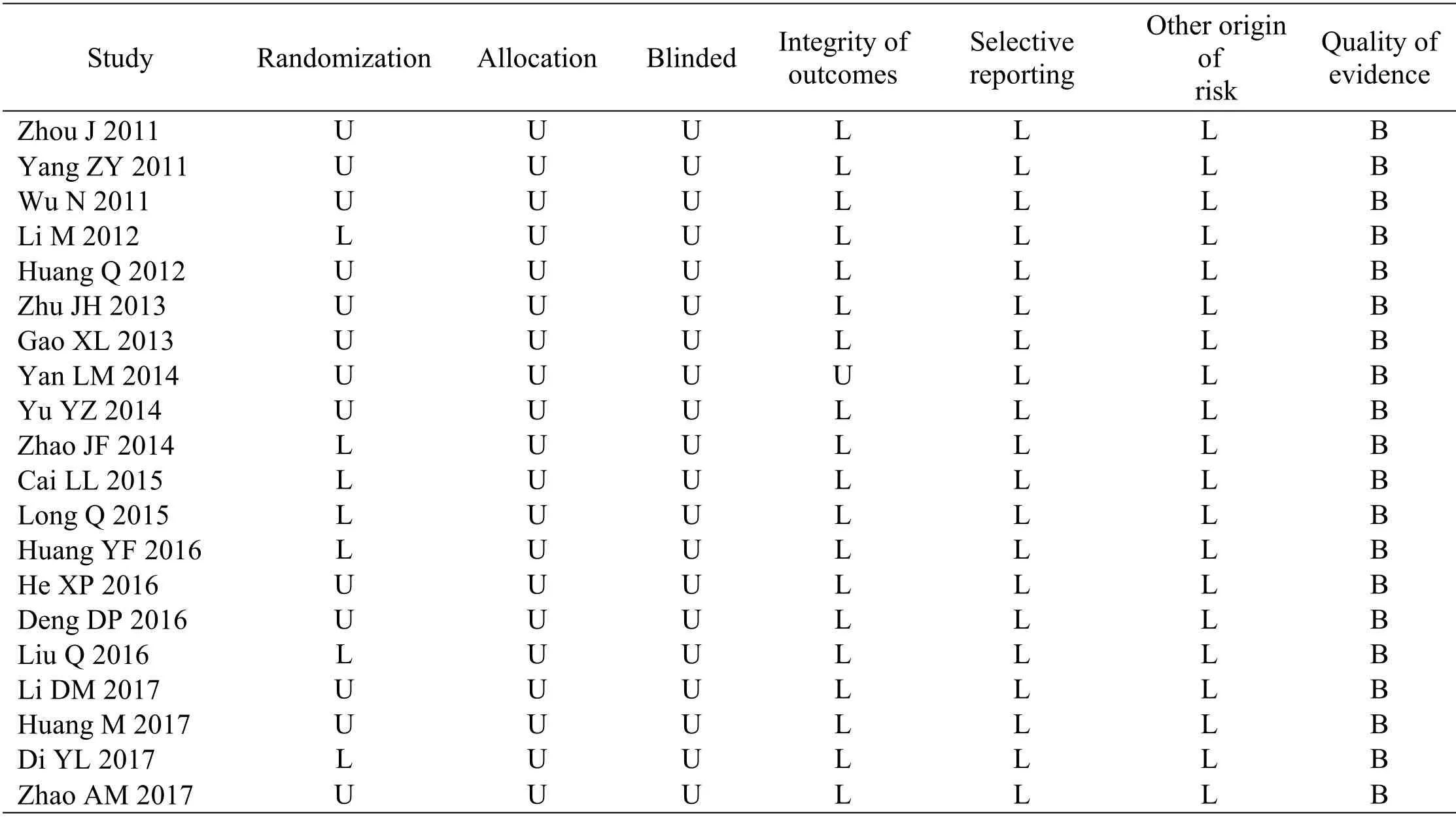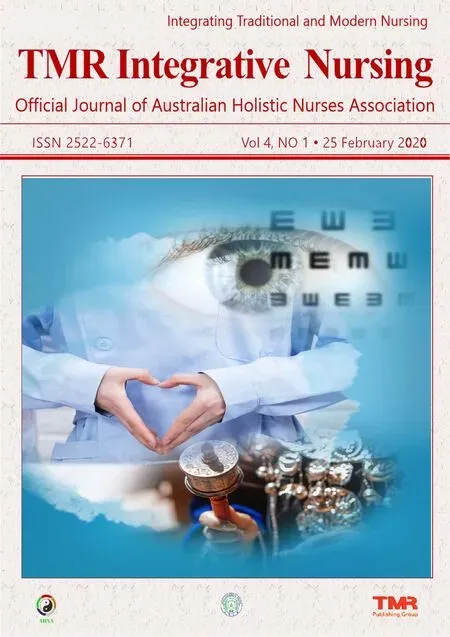Effect of auricular acupoint sticking and pressing on postoperative pain of patients with mixed hemorrhoids:A Meta-analysis
Qing-Long Wang,Hong-Mei Xu,Di Bao,Xiao-Li Pang
1NHC Key Laboratory of Hormones and Development (Tianjin Medical University), Tianjin Key Laboratory of Metabolic Diseases,Tianjin Medical University Chu Hsien-I Memorial Hospital &Tianjin Institute of Endocrinology, Tianjin , China; 2School of nursing,Tianjin University of traditional Chinese medicine,Tianjin,China.
Abstract
Keywords:Auricular pressure,Mixed hemorrhoids,Postoperative pain,Meta-Analysis
Introduction
Hemorrhoids, refers to the local mass formed by pathological hypertrophy, down-shift of the anal cushion and blood flow stagnation of the perianal vascular plexus [1].Hemorrhoids is the most common anorectal disease, and it is one of the diseases with the highest incidence.According to the location of the disease, it can be divided into internal hemorrhoids,external hemorrhoids and mixed hemorrhoids.Mixed hemorrhoids has both internal hemorrhoids and external hemorrhoids.The condition is more complicated than the latter two.When the symptoms are severe, the operation is routinely performed.Because of the rich nerves in this area, combined with the stimulation of inflammatory media release and defecation dressing change after operation, the postoperative pain is more serious [2], which directly affects the enthusiasm of patients to choose surgical treatment.Clinically, postoperative analgesia with mixed sputum is mainly based on drug treatment.Although the effect is considerable, there are still problems such as large adverse reactions, high cost,and easy addiction.At present, there is no recognized best solution [3, 4].Auricular acupoint pressing is based on the theory of human holography.By stimulating the acupoints of the ear to regulate the related meridian function,promoting blood circulation,regulating the viscera and yin and yang, and achieving the purpose of treating diseases, it has the advantages of simple and easy patient acceptance and high patient acceptance [5].In the ear, it is convenient to find the corresponding acupoints of the human rectum, anus and other organs.Acupuncture points can be obtained for the postoperative pain of the patient, and the acupuncture points can be used to obtain a good analgesic effect [6].This study comprehensively related randomized controlled trials to systematically evaluate the efficacy of auricular acupoint pressing for postoperative analgesia and common complications after mixed hemorrhoids, providing a reference for clinical application.
Materials and methods
Inclusion and exclusion criteria
(1) Inclusion criteria: (i) Type of study: Randomized controlled trials, whether or not blinded, the language is limited to Chinese and English.(ⅱ) Inclusion in the population:patients with mixed hemorrhoids who were treated with surgical methods; age ≥ 18; studies using various diagnostic criteria were included,including "criteria for the diagnosis and treatment of traditional Chinese medicine diseases", "criteria for the diagnosis and treatment of anorectal diseases of traditional Chinese medicine", "surgery", "Guidelines for the diagnosis and treatment of common diseases of traditional Chinese medicine in anorectology","Guidelines for clinical diagnosis and treatment of hemorrhoids".(ⅲ) Interventions: The control group used general nursing methods to relieve pain,including physical therapy (Chinese medicine fumigation, etc.),psychological care, etc.; the experimental group applied auricular acupressure to relieve pain on the basis of general care.(ⅳ) Observation indicators:clinical efficacy (pain relief efficiency, pain score);urine retention, edema, adverse reactions, etc.;efficiency: effective = effective number of pain relief /total number of treatment × 100%.
(2) Exclusion criteria.(i) Inclusion in the population with other diseases, such as anal fistula, perianal abscess, depression, anxiety and so on.(ⅱ) The experimental group applied intervention measures other than auricular acupoint pressing relative to the control group.(ⅲ) Repeated publications.(ⅳ) The article is of very low quality, incomplete information(such as surgical methods, anesthesia) or articles that cannot be obtained from the original text.5 Research objects, interventions, and outcome indicators are unclear articles.
Search strategy
The researches related to Postoperative pain in patients with mixed hemorrhoids were searched in Chinese and English databases.English databases are as follows:Cochrane library,PubMed,EMBASE and Web of Science.Chinese databases include: Chinese Biomedical Literature Database, WANFANG Data,VIP Database and CNKI.Determination of search terms: Search terms are determined through multiple pre-searches, with combination of MeSH and free text,and Subtle adjustments, are made based on specific databases.Search strategy: ((("Hemorrhoids" [Mesh])OR (((((hem-orrhoid [Title/Abstract]) OR piles[Title/Abstract]) OR hemorrhoids [Title/Abstract]) OR mixed hemorrhoid[Title/Abstract]) OR combined hemorrhoid [Title/Abstract]))) AND(((((((((ear-acupuncture [Title/Abstract]) OR auriculopressure [Title/Abstract]) OR auricularplaster therapy [Title/Abstract]) OR auricular acupuncture[Title/Abstract]) OR Acupressure [Title/Abstract]) OR acupoints [Title/Abstract]) OR Auricular acupressure[Title/Abstract]))OR"Auriculotherapy"[Mesh])
Study selection
Incorporate document deletion steps: (1) Apply the document management software check function to screen the same documents, and then perform a manual check.(2) Read the article title and abstract,and delete irrelevant articles.(3)Get the full text of the article after screening.(4)Read the full text and further screen the literature based on inclusion and exclusion criteria.(5) When the data is missing, contact the author as much as possible to obtain the data.(6)Determine the final inclusion of the article.Steps (1),(3),and(5)are completed by the first author,and steps(2), (4), and (6) are performed by the first author, and the second author independently completes and checks each other.If there is an objection, the discussion is made by two people or submitted to the author of the communication.
Data extraction and quality assessment
The process of data extraction and quality assessment was independently performed by two researchers with cross-checked.If there were inconsistent views between two researchers for the same research, the third researcher determines the final result after discussion.
Evaluating the quality of articles according to the possibility of bias."A": The evaluation results fully meet the criteria, the possibility of bias is low; "B":partly meet the criteria, there is a certain risk of bias;"C":completely not meet the criteria, the possibility of bias is high.
Statistic analysis
We used RevMan 5.3 to meta analyze the data.Count variables, applied with Odds ratio (OR) and 95%confidence interval (95% CI); continuous variables,applied mean difference (MD) or standardized mean difference (SMD) and 95% confidence Interval (CI)representation.We analyzed the heterogeneity of data using chi-square test.It was accepted and analyzed by fixed-effect model whenP>0.1,I2<50%.Conversely,there was heterogeneity among the data.We needed to analyze the origin of clinical and methodological heterogeneity, used random-effect model to combined effect.When the heterogeneity is obvious, subgroup analysis, sensitivity analysis or descriptive analysis would be used.Application of inverted funnel plot method to analyze whether literature has publication bias.
Results
Study selection and basic characteristics
A total of 523 Chinese documents and 114 English articles were detected, and 296 articles were obtained after removing duplicate articles.244 articles were excluded by reading topics and abstracts, and 52 articles were obtained.Further reading of 32 articles was completed, and 20 articles were eventually included, 21 The quantitative analysis of the research team included a total of 1999 patients.The deletion is shown in Figure1.The basic information of the study is shown in Table1.
Bias risk assessment
The methodological quality of 20 articles was rated as“B”.The evaluation results are shown in Table2.
Meta-analysis
The effectiveness of auricular acupoint pressing for postoperative pain in mixed hemorrhoids.Thirteen studies (12 articles) [2, 9, 11-14, 17, 20-22, 24, 25]reported the effectiveness of auricular acupoint pressing in the treatment of postoperative pain in mixed hemorrhoids, involving a total of 1316 patients.The study was divided into two subgroups by different surgical methods because of different surgical trauma and postoperative pain intensity.The study of milligan morgan group was homogenous (P= 0.81, I2= 0%).Using fixed-effects model analysis, the results showed that the application of auricular acupressure was more effective than the control group, and the combined effect was statistically significant [OR =3.68, 95% CI (2.62, 5.18),P<0.05].The study of the Stapler hemorrhoidectomy group was homogenous (P= 1, I2= 0%).Using the fixed effect model analysis,the results showed that there was no significant difference in the effective rate of auricular acupoint pressing and control group (P> 0.05).Subgroup analysis showed that the application of auricular acupressure after milligan morgan was superior to the control group in the analgesic effect [OR = 3.68, 95%CI (2.62, 5.18),P<0.05], but it is not yet possible to apply auricular acupoint pressing to relieve pain after stapler hemorrhoidectomy (P>0.05).as shown in Figure2.

Table1 Basic characteristics of the included studies

Note:a:milligan morgan;b:Stapler hemorrhoidectomy;c:Unclear.Anesthesia methods:1 subarachnoid anesthesia,2 combined spinal-epidural anesthesia, 3 local anesthesia, 4 lumbar-shu point anesthesia, 5 sacral anesthesia, 6 unknown.Outcome Indicators: ①Efficiency of treatment ②Pain score ③Urine retention ④Edema ⑤Adverse reactions.OM: Operative mode; AM: Anesthesia mode.Adverse reactions.Zhou Juna and Zhou Junb are two studies in an article.

Table2:Assessment of Bias Risk
Pain score.A total of 15 articles and 16 randomized controlled trials [1, 2, 8, 9, 12-14, 16-18, 20-24]reported post-operative pain scores.Because the pain was the most severe 24-48 hours after operation, the study that included 24 hours after operation and 48 hours after operation was combined.Twelve studies[1,2, 6, 8, 13, 14, 16-18, 21, 23] reported 24-hour post-operative pain scores.The combined results were heterogeneous (P<0.01, I2= 96%).Random effect model analysis showed that the pain scores of the Auricular Acupoint Plaster group were lower than those of the control group.The difference was statistically significant [SMD = -1.99, 95% CI(-2.84,-1.14),P<0.05].Nine studies [1, 2, 6, 13, 16-18, 23]reported the pain scores of 48 hours after operation.The combined results were heterogeneous(P<0.01,I2=94%).Random effect model analysis showed that the pain scores of the auricular acupoint sticking group were lower than those of the control group.The difference was statistically significant [SMD = -1.92,95% CI (-2.72, -1.11)].P<0.05].As shown in Figure3.
The effect of auricular acupoint pressing on urination.A total of 5 articles (6 studies)[1,2,20,23,25] reported the patient's urine retention, one of which was reported by count data, and the other five studies were combined.The results showed that there was no statistical difference between the two groups(P>0.05).It is still not considered that the application of auricular acupoint pressing after mixed hemorrhoids can improve the urinary symptoms of patients.As shown in Figure4.
Edema and adverse reactions.Four articles(5 studies)[1, 2, 23, 25] reported edema in patients, and qualitative analysis was performed because the forms of reporting were different and could not be converted.Five studies reported that the application of auricular acupoint pressure can alleviate the symptoms of postoperative edema in patients, and they are superior to the control group; five studies [1, 11, 20, 24, 25]reported adverse reactions using auricular acupressure.Conduct a qualitative analysis.One of the studies [1]reported the application of auricular acupoint pressure safety; four studies reported adverse reactions in the control group at the same time;Five studies showed that auricular acupoint pressing had no adverse reactions.Two articles[11,24]showed that the control group had adverse reactions (dizziness, nausea,vomiting).
Bias risk assessment.The 13 studies included in the analgesic efficiency were analyzed by funnel analysis.The results showed that the funnel plot was asymmetrical,suggesting that there may be publication bias.Observing the funnel plot, it can be seen that the asymmetry of the funnel plot is mainly due to the lack of the left side study, suggesting that the negative result study is published less.As shown in Figure5.
Discussion
Analysis of the effect of auricular acupoint pressing and analgesia
Pain is a common complication after operation of mixed hemorrhoids, and it is a hot and difficult research topic.Perianal nerve is abundant and pain is very sensitive.Mechanical injury during operation and release of pain-causing factors (K+, bradykinin,histamine, etc.) after operation enhance the sensitivity of peripheral and central nervous system, resulting in hypersensitivity of pain in patients.Postoperative defecation, dressing changes, secretions, etc.caused aggravation of pain, and pain caused anal sphincter spasm, causing persistent and severe pain.Postoperative pain causes anger, anxiety and other negative emotions, delays wound healing, and ultimately affects the patient's physical and mental health.At present, the clinical analgesic postoperative analgesia is mainly based on drugs, with various types and various analgesic pathways, such as intravenous analgesic pumps, oral painkillers, local injection analgesics, etc., but there are many disadvantages such as many adverse reactions, strong dependence, and high prices [27, 28].The ear acupuncture point is the ear acupuncture point where the ear is connected with each viscera."Lingshu·kou wen":The stimulating ear can play a certain conditioning effect on the corresponding viscera [2, 27].Auricular acupoint pressing is an important part of auricular acupoint therapy.It has the advantages of convenient operation,low cost and few side effects.It has achieved good results in pain relief after mixed hemorrhoids.This study summarizes its advantages and disadvantages, in order to provide further clinical promotion.This study shows that auricular acupoint sticking can relieve postoperative pain of patients with mixed hemorrhoids.Considering the great difference in the intensity of trauma and pain caused by different surgical methods,we divided the different surgical methods into two subgroups for analysis.The results showed that auricular acupoint pressing was effective in milligan morgan for pain relief, but it was ineffective after stapler hemorrhoidectomy.This may be related to the less pain caused by stapler hemorrhoidectomy, and the effect of this method was not significant.To further clarify the effect of auricular acupoint pressing on pain relief after mixed hemorrhoids surgery, the pain score was combined in this study.The combined results at 24 and 48 hours after operation showed that the experimental group was superior to the control group,but the heterogeneity between the studies was large.We tried to combine all the time points data and got similar results.Attempts to combine the same surgical and anesthetic methods have not reduced the heterogeneity among the studies.Considering the different indications for the use of analgesics in different hospitals, and the amount of analgesics directly affects the change of pain scores, combined with the use of analgesics, the results show that only six articles [1, 10, 15, 16, 20, 23] reported the use of analgesics, and the use of drugs, doses and reporting methods are different.To sum up,this study shows that auricular acupoint plaster is effective in treating postoperative pain of mixed hemorrhoids,but there are still some problems to be discussed.
Other indicators
Urine retention.Urinary retention is one of the common complications in the early stage after operation of mixed hemorrhoids.The causes include nervous tension,anesthesia,pain and so on.Traditional Chinese medicine studies have found that urinary retention after operation of mixed hemorrhoids is caused by injury of meridians caused by surgical trauma, stagnation of Qi and blood, which leads to urinary retention caused by dysfunction of bladder gasification.Stimulation of auricular acupoints can stimulate and repair damaged meridians and collaterals,restore their regulatory function,thereby improving the condition of urine retention [20].This study combined 5 related studies.The results showed that auricular acupoint pressing could not improve the micturition of patients with mixed hemorrhoids after operation.After eliminating a study with opposite conclusion [1], the combined result of the experimental group is better than that of the control group, which shows that the combined result is unstable, and because of the small number of synthetic samples and the quality deviation,the conclusion can not be reached,and still needs to be verified by the large sample of high-quality research.
Edema."Suwenyinyangyingxiangdalun" says, "Qi hurts, shape hurts and swells" the body is injured, and Qi and blood will be injured, Qi stagnation will be injured, blood vessels blocked into swelling and pain.Auricular acupoint sticking and stimulating acupoints can make the zang-fu meridians and collaterals Qi and blood clear and treat edema after hemorrhoids operation [23].The results of this study show that auricular acupoint pressing can alleviate the edema symptoms of patients with mixed hemorrhoids after operation.Due to less research and poor quality of research, this conclusion still needs to be further explored.
Adverse reactions.The safety of therapy is an eternal topic of concern in the medical field.This study shows that there are no adverse reactions to auricular acupoint sticking in the report articles, suggesting that this method has good safety.With the improvement of people's safety consciousness, non-drug therapy and green therapy are more and more popular.Auricular acupoint sticking is a kind of acupuncture and moxibustion therapy.Its convenient operation and safety have been confirmed by many studies[30-32].
Intervention methods and evaluation methods
Interventionmethods.Acupoint selection,intervening time and pressing frequency are the core elements of auricular acupoint sticking therapy.There are differences in the implementation methods of this study included in the article.According to the results of selecting acupoints in all articles, the five acupoints were selected most frequently, in order: Shenmen (18 articles), Anus (13 articles), Rectum (13 articles),Sympathy (11 articles), Subcortical (11 articles).Shenmen acupoint is mainly for insomnia, dreaminess and pain, subcortical acupoint is for pain, neurasthenia and insomnia.These two acupoints are the key points to relieve pain and calm the mind.Anal acupoint is for hemorrhoids, anal fissure, and rectal acupoint is for prolapse of anus and hemorrhoids.These two acupoints can restore the operation of Qi and blood in the affected area, and play the role of analgesia,hemostasis and detumescence.Vegetative nerve dysfunction has the effect of relieving Qi, promoting blood circulation and relieving pain.The reasonable combination of the above points has obvious effect on pain after hemorrhoids operation.It is suggested that clinical selection be made.Press frequency and time are not uniform, and the best scheme still needs to be further studied.
Evaluation methods.This study found that there were significant differences in the evaluation results among the included studies, which were reflected in the evaluation tools, evaluation time and the use of analgesics in the control group.Suggestions: ①Pain evaluation methods applied to international standards;② It is better to use pre-intervention and post-intervention measurements to compare the difference between the two groups to analyze the post-operative analgesic effect; ③Detailed reports on the types and quantities of analgesics used.
To sum up, auricular acupoint sticking can effectively improve the pain symptoms of mixed hemorrhoids after external stripping and internal ligation, with fewer adverse reactions and economic benefits.It is recommended that clinical application.
- Nursing Communications的其它文章
- Research progress of Kinesiophbia in patients with temporomandibular disorders
- Cross-cultural nursing's systematic model and its application in minority patients in China
- Early diagnosis and management of Congenital diaphragmatic hernia
- Analysis of the present situation and influencing factors of self-perceived burden in primary glaucoma patients

